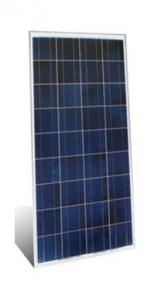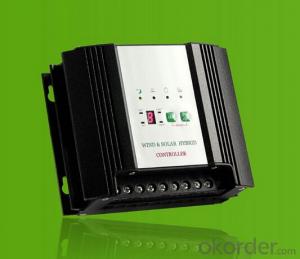Max. PV Input 100V Solar Charge 12V/24V Controller 15A MPPT with LCD
- Loading Port:
- China main port
- Payment Terms:
- TT OR LC
- Min Order Qty:
- 20 unit
- Supply Capability:
- 9999 unit/month
OKorder Service Pledge
OKorder Financial Service
You Might Also Like
Max. PV Input 150V Solar Charge 12V/24V Controller 15A 20A 30A 40A 50A MPPT with LCD
I-P-Wiser 1 series adopted with auto cool, high conversion efficiency, LCD display and free PC software. It features an efficient MPPT control algorithm to track the maximum power point of the PV array in any environment. Greatly improve the utilization of solar panel. Also added the output function(USB 5V 3A). For the mppt controller can be widely used in off-grid solar system, Communication base station solar system, household solar systems, street light solar systems, field monitoring and other fields.
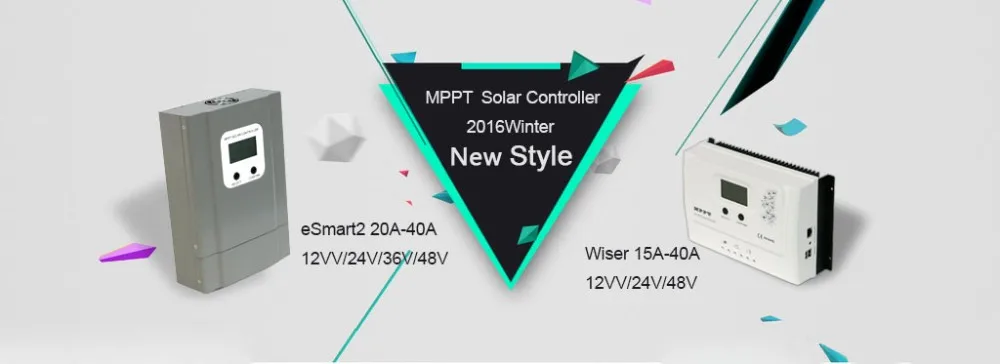
| Product Show |
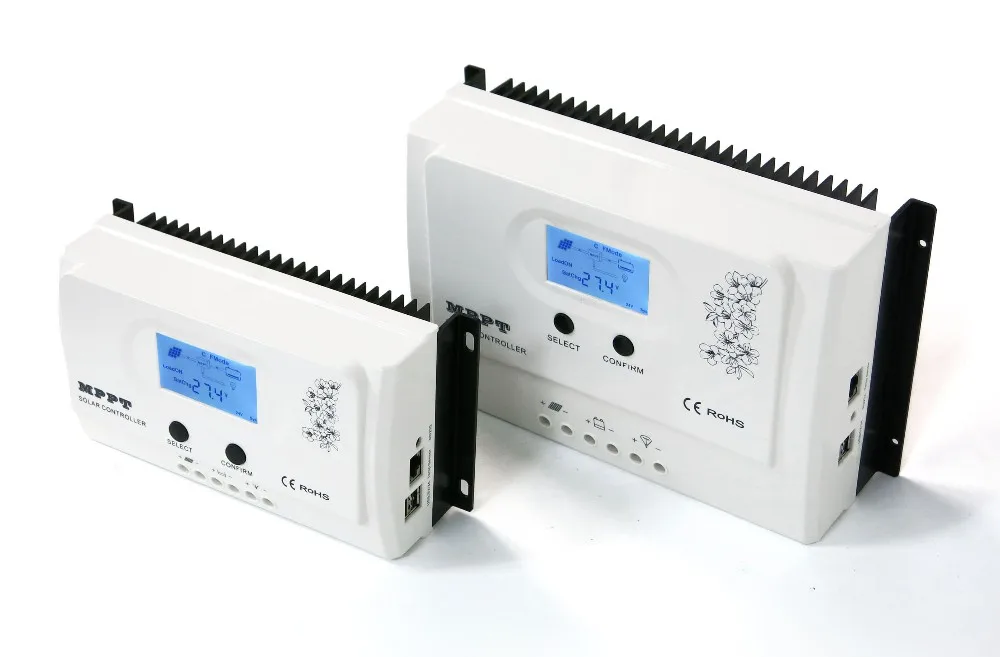
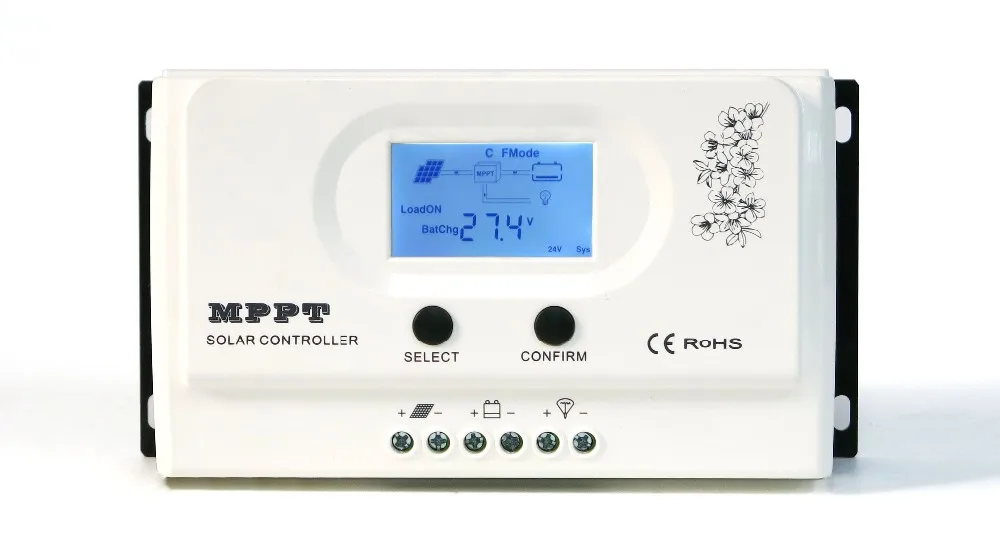
| MPPT Controller connection diagram |
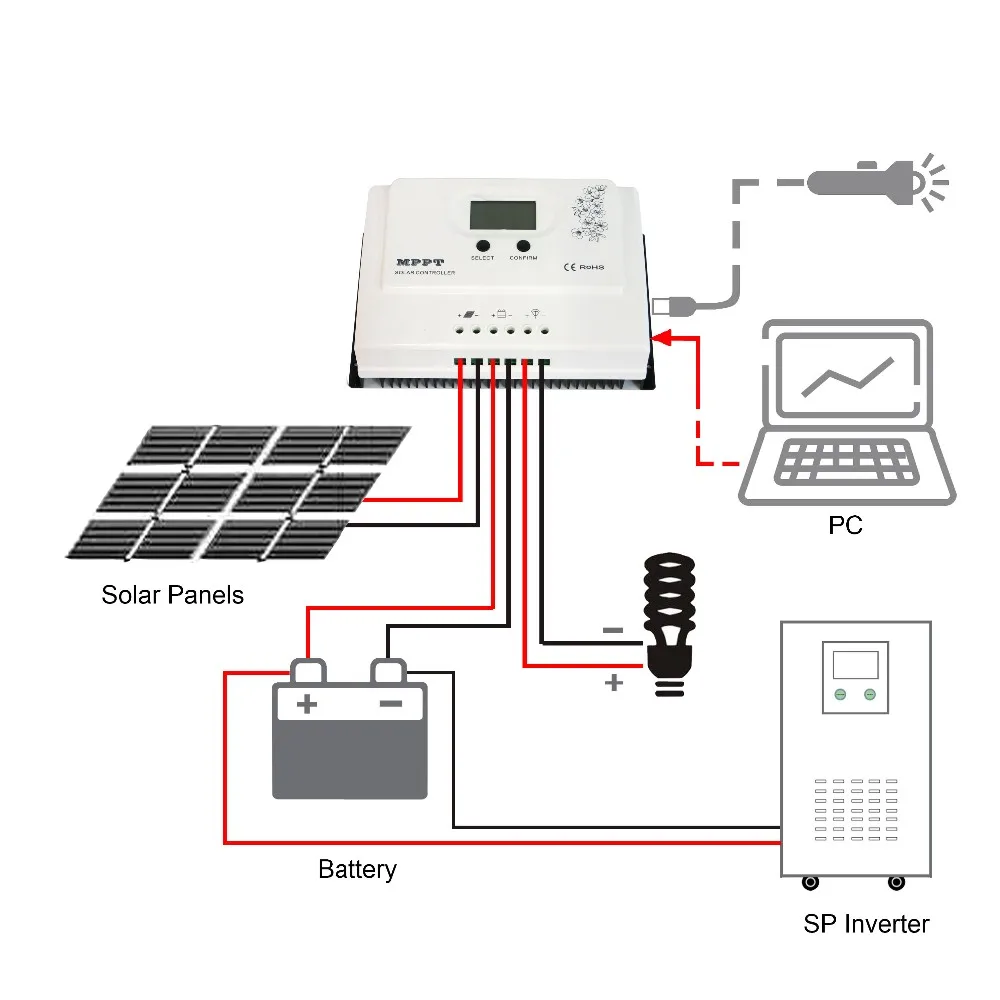
| Features |
1.High efficiency MPPT control algorithm, MPPT efficiency ≥99.5%, whole Machine conversion efficiency upto 98%;
2.12V/24V system Automatic Recognition,users can use it in different system conveniently.
3.Maximum PV input voltage: 100VDC(15A, 20A), 150VDC (30A, 40A,50A)
4.Charge mode: three stages (fast charge, constant charge, floating charge). It prolongs service life of the batteries.
5.Discharge mode: ON/OFF mode, PV voltage control mode.
6.Recommended battery types: sealed lead acid, vented, gel, NiCd battery. Other types of the batteries can also be defined.
7.Most information could be provided by LCD like: system type., PV input voltage, battery type, battery voltage, charging current, charging power, working status and so on. Also customer's information like company name, website and logo can be added into Solar Eagle software.
8.RS232 communication, we can offer communication protocol also, it’s convenient for user’s integration management.
9.CE, RoHS, FCC certifications approved.. We can help clients to approve other certifications.
10.2 years warranty. And 3~10 years extended warranty service also can be provided.
Upper Computer Software and Test Software |
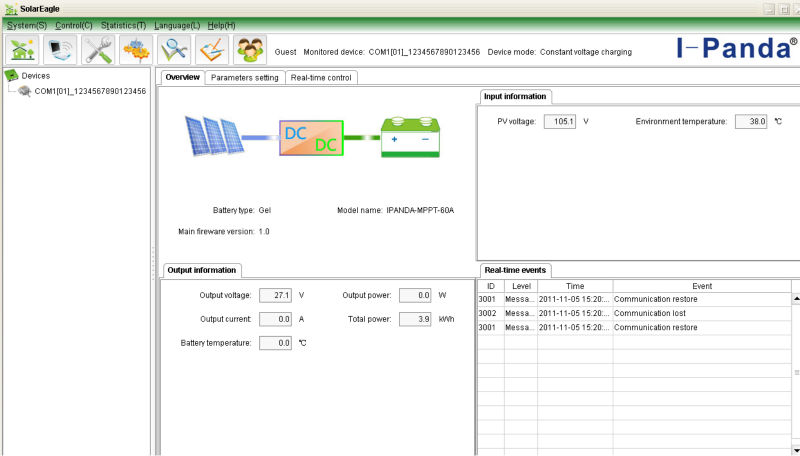
PC software_SolarEagle
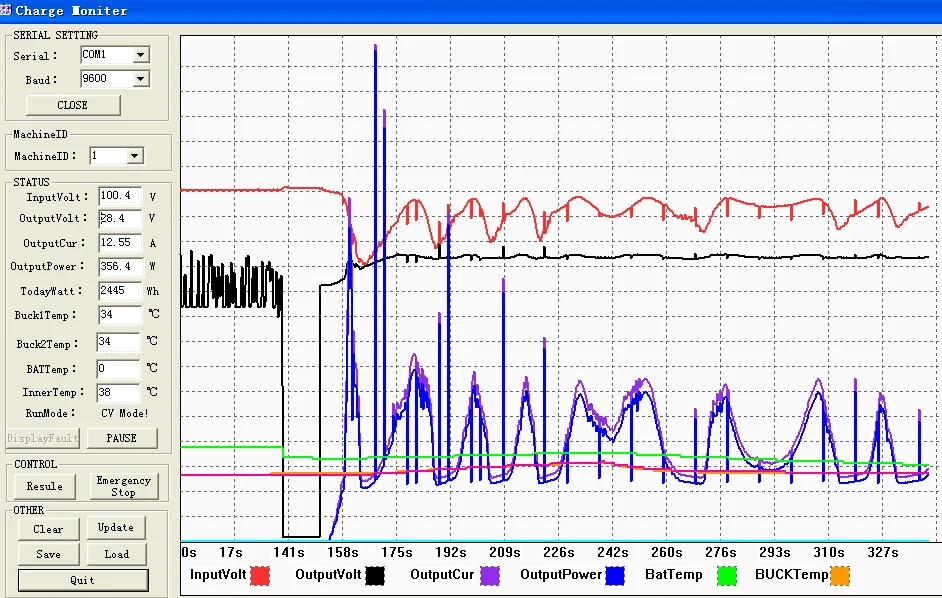
Monitoring software
Visual display of charge and discharge status, PV voltage, charge voltage, charge current, and can set the battery type, LOAD output control;
parameters |
Model: | 15A | 20A | 30A | 40A | 50A | |
I-P-Wiser 1-12V/24V-Series | ||||||
Charge mode | MPPT(maximum power point tracking) | |||||
MPPT efficiency | ≥99.5% | |||||
System type | DC12V/24V system | Automatic Recognition | ||||
INPUT CHARACTERISTICS | ||||||
PV Max PV input voltage(VOC) | 12V/24V system | DC100V | DC150V | |||
Start the charging voltage point | 12V system | 18V | ||||
24V system | 32V | |||||
High input voltage protection point | 12V/24V system | DC100V | DC150V | |||
High input voltage recovery point | 12V/24V system | DC95V | DC145V | |||
Rated PV power | 12V system | 200W | 260W | 390W | 520W | 650W |
24V system | 400W | 520W | 780W | 1040W | 1300W | |
CHARGE CHRECTRESTICS | ||||||
Selectable Battery Types | 12V/24V system | Sealed lead-acid batteries, Vented batteries Gel, NiCd battery (Other types of the batteries also can be defined) | ||||
Charge method | 12V/24V system | Three stages charge: constant current(MPPT), constant voltage, floating charge | ||||
Charge rated current | 12V/24V system | 15A | 20A | 30A | 40A | 50A |
OUTPUT DISCHARGE CHARACTERISTICS | ||||||
USB (Total for 2 USB output) | DC5V 3A | |||||
LOAD output voltage | Based on battery voltage | |||||
Max. DC Load current | 30A | |||||
Output control mode | ON/OFF mode, PV voltage control mode | |||||
Output control set way | Controller button or PC software | |||||
DISPLAY | ||||||
LCD Display | System type, PV voltage,charge voltage, charging current, charging power, temperature etc. | |||||
PC software | RS232 | |||||
OTHER PARAMETERS | ||||||
Protection function | Yes (Over voltage, low voltage, over temperature, over load, Short circuit protection etc.) | |||||
Cooling mode | Auto cool | |||||
Type of Mechanical Protection | IP 30 | |||||
Measurement DxWxH (mm) | 200*110*66 | 243*155*79 | ||||
Packing DxWxH (mm) | 249*144*105 | 289*189*113 | ||||
N.W. (KG) | 0.9 | 1.8 | ||||
G.W. (KG) | 1.3 | 2.2 | ||||
Certifications |
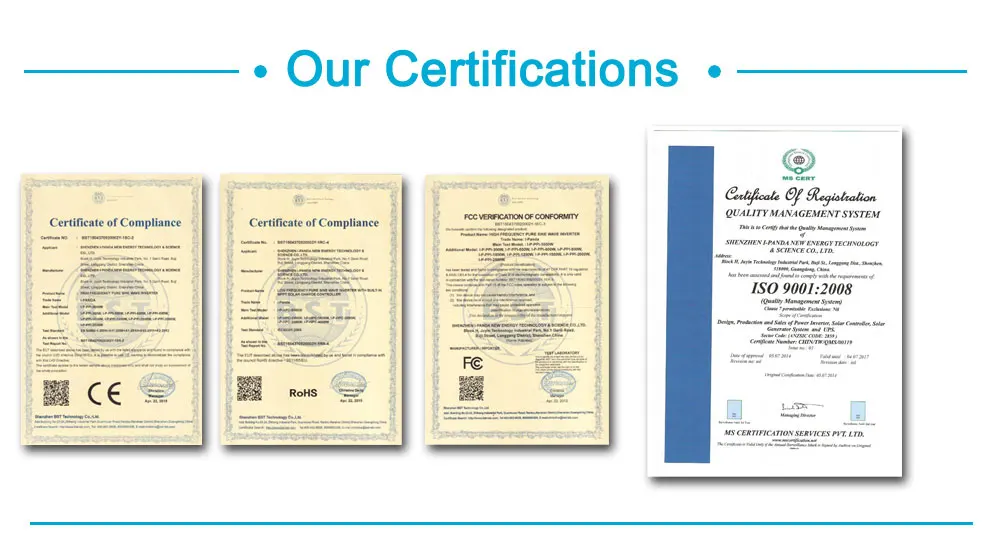
F&Q: |
Q1. How to ensure and monitor the products quality?
A1: We have established a perfect Quality Management System, In strict
accordance with ISO9001: 2008 quality system and ISO14001 environment system for quality assurance management;
Our ISO9001:2008 Quality System certificate encoding: CHIN/TW/QMS/00119;
Our ISO14001 Environment System certificate encoding: CHIN/TW/EMS/00028;
Q2. What is the warranty of products?
A2: The warranty period of different products are different; 5 years, 3 years, 2 years, 1 years; More details please refer to the product specification or manual; we will provide free life-long technical support ;
Q3. What is the difference between MPPT&PWM?
A3. MPPT charging mode, peak efficiency up to 99%, saving 30%~60% solar panel than traditional PWM controller.
- Q:What is the maximum discharge voltage for a solar controller?
- The maximum discharge voltage for a solar controller typically depends on its design and specifications. However, it is generally recommended to keep the discharge voltage between 11.5 and 12.5 volts to prevent over-discharge and potential damage to the battery.
- Q:What is the maximum load power of a solar controller?
- The maximum load power of a solar controller typically depends on the specific model and brand. It can range from a few hundred watts to several kilowatts, catering to different power requirements for various applications.
- Q:What is the maximum output current for a solar controller?
- The maximum output current for a solar controller typically depends on the model and specifications of the specific solar controller. It can range from a few amps to several hundred amps, depending on the capacity and design of the controller.
- Q:Can a solar controller be used with flooded batteries?
- Yes, a solar controller can be used with flooded batteries. Solar controllers are designed to regulate the charging process of batteries, including flooded batteries. They help prevent overcharging and maintain the battery's optimal performance and longevity.
- Q:Can a solar controller be used with a solar-powered office building?
- Yes, a solar controller can be used with a solar-powered office building. A solar controller regulates and optimizes the flow of electricity between the solar panels and the building's energy system, ensuring efficient and safe operation. It helps manage the charging and discharging of batteries, protects against overcharging or overvoltage, and monitors the overall performance of the solar power system in the building.
- Q:Can a solar controller be used in a solar-powered lunar base?
- Yes, a solar controller can be used in a solar-powered lunar base. Solar controllers are essential components in solar power systems as they regulate the flow of electricity from the solar panels to the batteries, ensuring proper charging and preventing overcharging. In a lunar base, where solar power would be the primary source of energy, a solar controller would be necessary to efficiently manage the power generated by the solar panels and ensure the batteries are charged optimally.
- Q:What is the maximum load capacity a solar controller can handle?
- The maximum load capacity that a solar controller can handle varies depending on the specific model and its specifications. It is important to refer to the manufacturer's documentation or consult with a professional to determine the maximum load capacity of a particular solar controller.
- Q:How does a solar controller regulate the charging current?
- The charging current of the solar panel and battery is regulated by a solar controller, which monitors the voltage and current levels. Its purpose is to prevent overcharging of the battery by limiting the current flow when the battery reaches its maximum voltage. To achieve this regulation, the controller employs either pulse width modulation (PWM) or maximum power point tracking (MPPT) techniques. In a PWM solar controller, the controller controls the average charging current by rapidly turning the solar panel's current on and off. When the battery voltage is low, the controller allows a maximum charging current, which gradually decreases as the battery voltage rises. This prevents overcharging and damage to the battery. On the other hand, an MPPT solar controller utilizes a more advanced algorithm to continuously track the maximum power point (MPP) of the solar panel. The MPP represents the optimal voltage and current combination at which the solar panel can deliver its maximum power output. The controller adjusts the charging current accordingly to ensure that the panel operates at its MPP, resulting in maximum power transfer to the battery. Both PWM and MPPT controllers are efficient in regulating the charging current, thus preventing overcharging and extending the battery's lifespan. The choice between the two depends on factors such as the characteristics of the solar panel, battery type, and system requirements.
- Q:Can a solar controller be used with MPPT (Maximum Power Point Tracking) technology?
- Yes, a solar controller can be used with MPPT (Maximum Power Point Tracking) technology. In fact, MPPT is a feature of certain advanced solar controllers that allow them to extract maximum power from solar panels by adjusting the operating point to the most efficient level. This technology helps in maximizing the overall efficiency and performance of a solar system.
- Q:Can a solar controller be used with sealed batteries?
- Yes, a solar controller can be used with sealed batteries.
1. Manufacturer Overview |
|
|---|---|
| Location | |
| Year Established | |
| Annual Output Value | |
| Main Markets | |
| Company Certifications | |
2. Manufacturer Certificates |
|
|---|---|
| a) Certification Name | |
| Range | |
| Reference | |
| Validity Period | |
3. Manufacturer Capability |
|
|---|---|
| a)Trade Capacity | |
| Nearest Port | |
| Export Percentage | |
| No.of Employees in Trade Department | |
| Language Spoken: | |
| b)Factory Information | |
| Factory Size: | |
| No. of Production Lines | |
| Contract Manufacturing | |
| Product Price Range | |
Send your message to us
Max. PV Input 100V Solar Charge 12V/24V Controller 15A MPPT with LCD
- Loading Port:
- China main port
- Payment Terms:
- TT OR LC
- Min Order Qty:
- 20 unit
- Supply Capability:
- 9999 unit/month
OKorder Service Pledge
OKorder Financial Service
Similar products
New products
Hot products
Hot Searches
Related keywords





